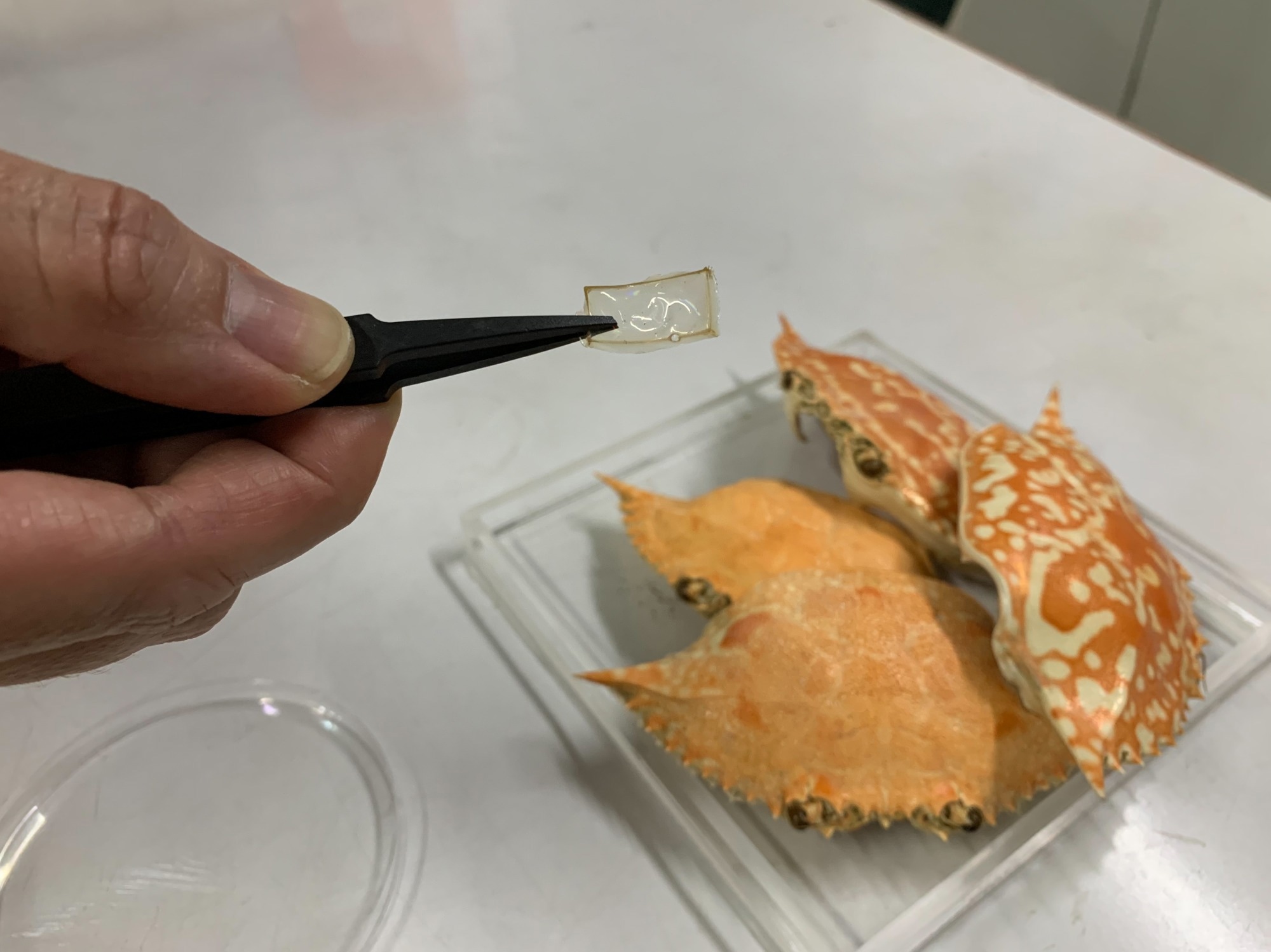Researchers have created a process to convert crab shells into a bioplastic that can be used to make optical components known as diffraction gratings. The resultant biodegradable, lightweight, and reasonably priced gratings could make it possible to produce disposable, portable spectrometers.
 Researchers developed a process to turn crab shells into a bioplastic that can be used to make optical components known as diffraction gratings (in the tweezers). Image Credit: Raphael A. Guerrero, Ateneo de Manila University
Researchers developed a process to turn crab shells into a bioplastic that can be used to make optical components known as diffraction gratings (in the tweezers). Image Credit: Raphael A. Guerrero, Ateneo de Manila University
The Philippines is known for delicious seafood, but this industry is also a source of large amounts of solid waste such as discarded crab shells. We wanted to find an alternative use for crab shell waste, and decided to find out if chitosan from crab shells could be used as a biodegradable replacement for silicone, which we had previously used in our lab to make diffraction gratings.
Raphael A. Guerrero, Research Team Leader, Ateneo de Manila University
In the Optica Publishing Group journal Applied Optics, the researchers have demonstrated how the chitosan-based bioplastic can be used to make diffraction gratings that work just as well as the ones that are commercially available.
Guerrero added, “Gratings made of chitosan are biodegradable and environmentally friendly while also being very inexpensive since crab shells are generally considered waste. By showing that useful optical components can be made from materials typically considered waste, we hope to help improve sustainability in optical manufacturing and reduce the amount of seafood waste that requires disposal.”
Turning Crab Shells into Optics
The researchers chose to explore chitosan due to its promising optical properties. In its purified form as a solution, chitosan is transparent and can be molded in a similar manner as silicone while having a higher refractive index, which is crucial for certain applications.
The researchers obtained crab shells from a nearby processing facility, cleaned them, and dried them in an oven to extract the chitosan. The shells were subsequently crushed into a powder and chemically converted into a chitosan solution.
Soft lithography, a replication procedure that employs a silicone mold to replicate an object’s nanoscale surface properties, was used by the researchers to create gratings from the chitosan solution.
This involved preparing a silicone cast of a commercially available diffraction grating and pouring the chitosan solution into it. When the solution hardened, it created a replica of the commercial grating.
“Unlike subtractive methods such as laser etching, our soft lithography technique does not create chitosan waste. We can also modify the physical properties of chitosan to better fit a particular need by changing the chemical steps used,” Guerrero further added.
The surface of a diffraction grating includes thousands of small grooves that can separate white light into its many colors. The expected rainbow pattern was easily seen when white light was used to illuminate a chitosan grating.
Researchers also utilized atomic force microscopy to ensure that the chitosan grating’s groove spacing was identical to that of the original commercial grating. The chitosan diffraction gratings were then tested with a laser beam, and were found to produce the desired diffraction patterns..
Single-Use Spectrometers
“Diffraction gratings are the primary components of spectrometers, instruments used in a variety of industrial and scientific applications to analyze the way that light interacts with a sample to determine its chemical composition. Conventional gratings are typically made of heavy materials such as glass, but gratings made of chitosan could be used to make lighter and less expensive spectrometers,” Guerrero pointed out.
The chitosan gratings have not yet been put to the test for sturdiness, but the researchers claim that they are suitable for fieldwork spectrometers that are disposable. Such a device could be used, for instance, to examine food or drug products on the factory floor or water contamination in a stream.
Devices made from chitosan would have a minimal environmental impact due to the material’s biodegradability. To make the chitosan gratings useful for real-life applications, they are also attempting to increase their power efficiency.
Guerrero concluded, “For communities engaged in the crab industry, particularly in the Philippines, our findings add value to their seafood product, since even the waste components could find use in optical manufacturing. With proper collaboration between businesses and the local government, chitosan extracted from crab shells could lead to increased income and a better quality of life for crab fishermen and their families.”
Journal Reference:
Gumayan, E. G., et al. (2023) Chitosan from crab shell waste for soft lithography of bioplastic diffraction gratings. Applied Optics. doi:10.1364/AO.483336.